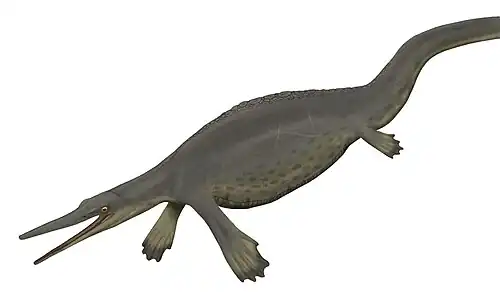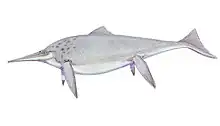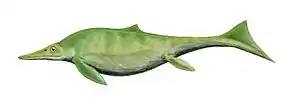| Thalattoarchon Temporal range: Middle Triassic, Late Anisian | |
|---|---|
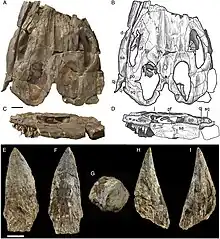 | |
| Skull and tooth from the holotype (FMNH PR 3032) | |
| Scientific classification | |
| Domain: | Eukaryota |
| Kingdom: | Animalia |
| Phylum: | Chordata |
| Class: | Reptilia |
| Order: | †Ichthyosauria |
| Genus: | †Thalattoarchon Fröbisch et al., 2013 |
| Type species | |
| †Thalattoarchon saurophagis Fröbisch et al., 2013 | |
Thalattoarchon is an extinct genus of large predatory ichthyosaurs that lived in the Middle Triassic (Anisian) in what is now North America, between 244.6 to 242 millions years ago. The only known species is T. saurophagis, described in 2013 from a single specimen discovered in the Favret Formation, Nevada (United States). The generic name, meaning "ruler of the seas", refers to its status as an apex predator, while the specific epithet, meaning "lizard eater", alludes to its carnivorous diet.
As an ichthyosaur, Thalattoarchon had flippers for limbs and a fin on the tail. It is a large ichthyosaur, its size being estimated at around 8.6 meters (28 ft) long, although the authors are doubtful about the exact measurements. The animal has a long, slender body but with a proportionally large head and a straight, elongated tail. The jaws of Thalattoarchon feature large teeth of up to 12 centimeters (0.39 ft), which would have been well suited for attacking large prey. Although the fossils are incomplete, it is estimated that the animal would have had a skeleton comprising at least 60 presacral vertebrae.
The classification of this genus within the ichthyosaurs is much debated, being either classified within the clade Merriamosauria, or in the more basal family Cymbospondylidae. Thalattoarchon certainly occupied the highest place in the food web within the Favret Formation, its sharp and cutting teeth suggesting that it would have mainly preyed on contemporary marine reptiles. Its position as a apex predator is generally compared to that of orcas, which have a similar lifestyle.
Discovery and naming
The only currently known specimen of Thalattoarchon was discovered in 1997 by the paleontologist Jim Holstein during a field expedition in the Augusta Mountains, located in Nevada, United States.[1] It was with the support and a grant from the National Geographic Society that the fossils were completely exhumed in 2008,[1][2][lower-alpha 1] after a period of work of three weeks. The imposing measurements of the fossils led paleontologists to transport the recovered material by using a helicopter and a truck out of the field.[3] The fossils were excavated in the Taylori Zone of the Fossil Hill Member in the Favret Formation, dating to approximately 244.6 million years ago, from the beginning of the late Anisian of the Middle Triassic. After preparation, the specimen, cataloged as FMNH PR 3032, consists of a major part of the skull and the axial skeleton, including parts of the pelvic girdle and rear swimming paddles.[1]
It was in 2013 that this specimen was designated as the holotype of a new genus and species of ichthyosaurs, under the name of Thalattoarchon saurophagis in the scientific journal Proceedings of the National Academy of Sciences. The genus name comes from Ancient Greek θάλασσα (thálassa, "sea"), and ἀρχός arkhós, "ruler"), all literally meaning "rulers of the seas",[1] directly referencing the animal's imposing size and position as an apex predator of the Triassic seas.[3] The specific epithet also comes from Ancient Greek and is derived from the words σαῦρος (saûros, "lizard") and φᾰγεῖν (phageîn, "to eat"), the two terms together literally meaning "lizard eater", in reference to its carnivorous diet . Due to the limited volume, the anatomy of the animal is only briefly described in the main article by Nadia B. Fröbisch and colleagues,[1] with additional anatomical descriptions being published in a secondary article.[4]
Description
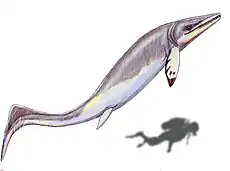
Although the only known specimen of Thalattoarchon is partially preserved, estimates of its size peg it at over 8.6 meters (28 ft) long, making it one of the largest known ichthyosaurs, having a size and morphology similar to some species of the contemporary genus Cymbospondylus.[1][2][3] However, due to some missing parts of this same specimen, the authors must await ongoing preparations and future discoveries to refine the estimates.[1] In 2021, Sander and colleagues propose that the animal would reach a body mass of 4.3 metric tons (4.7 short tons).[5] Like all other ichthyosaurs, Thalattoarchon has four flippers, but unlike the more derived representatives dating from the Jurassic and Cretaceous, the latter has a long, poorly developed caudal fin, unlike the two caudal lobes present in later ichthyosaurs. A trait rarely observed in representatives of the group, the animal's head is remarkably large in proportion to its body,[1] the size of the skull being estimated at 1.2 meters (3.9 ft) long.[4] The skull of Thalattoarchon is proportionally shorter but more robust than those of other ichthyosaurs, a characteristic suggesting that it fed on large prey.[6]
Skull

Although the skull of the only known specimen of Thalattoarchon is partially preserved, missing the entire rostrum and the front of the mandible, the latter is still well preserved and allows it to be viewed as a whole. The eye sockets are elongated, reaching up to 29 cm (11 in), and each have sclerotic rings. The superior temporal fenestrae are large and oval, sharing a similar shape to those of Shastasaurus. The maxillae extend well below the eye sockets and carry large teeth all the way to their posterior ends.[1] The nasal bones are very extensive and come into contact with the postorbital bones, but do not extend as far as the superior temporal fenestrae. The frontal bones are smaller, surrounding the anteromedial edge of the superior temporal fenestrae, but entirely surrounding the pineal foramen. In front of the pineal foramen there is a small sagittal crest which takes on the shape of a large plate further back. The parietal bones are smaller than the frontal bones and medially form the superior temporal fenestrae. The lacrimal bones and jugal bones are narrow and slender in shape.[4]
The palate, although partially preserved, appears to be dominated by the large pterygoid bones. In the lower jaw, the dentary bone extends to the level of the maxillae but apparently lacks teeth when it reaches the latter. This means that at least the fifth or sixth tooth in the maxillae would be missing a front tooth in the mandible. The surangular has a distinct coronoid process located posterior to the eye sockets.[4] Although the only known teeth of Thalattoarchon are located at the posterior level of the maxillae, it is possible that their size would increase towards the middle of the jaws. This morphological trend is also observed in many ichthyosaurs and other now extinct marine reptiles, such as mosasaurs, thalattosuchians and pliosaurs. The largest preserved tooth is at least 12 cm (4.7 in) long, with the crown alone measuring 5 cm (2.0 in). The teeth represent one of the main autapomorphies of Thalattoarchon, being large and thin, having two sharp edges each and a fairly smooth crown. The related genus Himalayasaurus has very similar dentition, but the latter differs from Thalattoarchon by the presence of longitudinal grooves on the crown.[1] The teeth of Thalattoarchon would also have been adapted for cutting prey.[4]
Postcranial skeleton
Although the total number of vertebrae is not known in the animal, it is estimated that it would have had at least 60 presacral vertebrae. The anterior dorsal vertebrae are almost round in anteroposterior view and measure 10 cm (3.9 in) in diameter and 6 cm (2.4 in) long. This latter measurement remains constant throughout the pre-sacral spine as well as in the most anterior caudal vertebrae, except at the level of the middle dorsal vertebrae, which reach 12 cm (4.7 in) in diameter. The neural spines of the anterior dorsal vertebrae are larger than the vertebrae themselves, measuring 13–14 cm (5.1–5.5 in) tall, being flattened laterally, and not sharing spaces when viewed from the sides. The anterior dorsal vertebrae are associated with ribs having only a single head, unlike the double-headed ribs present in the cervical vertebrae. The posterior dorsal vertebrae are the same height and length as the middle dorsal vertebrae. However, the latter are characterized for having a flattened ventral surface and articular facets for the double-headed ribs, a trait also observed in some basal ichthyosaurs and in neoichthyosaurians dating from the Late Triassic to the Cretaceous.[4]
The caudal vertebrae of Thalattoarchon are laterally flattened and are twice as tall as they are wide, gradually decreasing in length. Large facets for the haemal arches, or chevrons, are present on the anterior cervical vertebrae. The animal's tail appears to be rather straight, having visibly no curvature and not having a turned-down end.[4]
Few bones are preserved in the pelvic girdle and hind limbs, the only one fully preserved being the right ilium. The acetabulum of this bone is similar to that of Cymbospondylus, but its dorsal portion tapers to a point, meaning that the latter had only a weak connection with the sacral ribs. The femur is flattened and broad, having a slightly narrowed body and an enlarged distal end, being on the whole broader than that of Cymbospondylus. Another preserved bone is interpreted as a zeugopodial element, but it is uncertain whether it is a tibia or a fibula. Regardless, the latter has a concave margin, enlarged ends, and is wider than long. Thus, the hind limbs and the pelvic girdle are proportionally small in relation to the body of the animal, with just the length of the femur being twice the height of the caudal vertebrae.[4]
Classification
In the first classifications published by Fröbisch and colleagues in 2013, Thalattoarchon is classified as a basal representative of the Merriamosauria clade,[1] being seen as more derived than Cymbospondylus and the Mixosauridae, but recovered in an unresolved polytomy with Besanosaurus, Californosaurus and Toretocnemus.[4] However, in 2015, a phylogenetic revision carried out on the ichthyopterygians by Cheng Ji and his colleagues moved Thalattoarchon within the Cymbospondylidae, i.e. in a more basal position than the Merriamosauria as proposed two years earlier.[7] This classification was generally accepted and retained in several phylogenetic analyzes concerning ichthyosaurs published from 2016 until 2021.[8][9][10][11] In 2017, Benjamin C. Moon provisionally reclassified Thalattoarchon in the Merriamosauria, but his study proposing several cladograms for the genus, including a certain number classifying it again in the Cymbospondylidae, its positioning is then seen as not definitive.[9] In 2021, Paul Martin Sander and his colleagues unanimously reclassified Thalattoarchon within the Merriamosauria, but this time in a position situating it as a sister taxon of the Shastasauridae.[12][5]
The following cladogram shows the position of Thalattoarchon within the Ichthyosauria after Sander et al., (2021):[12][5]
| Ichthyosauromorpha |
| ||||||||||||||||||||||||||||||||||||||||||||||||||||||||||||||||||||||||||||||||||||||||||||||||||||||||||||||||||||||||||||||||||||||||||||||||||||||||||||||||||
Paleobiology
Due to its teeth, Thalattoarchon is recognized as having been an apex predator, the abundant presence of marine reptiles within the Favret Formation suggesting that the animal would have regularly attacked the latter. Its position as a apex predator is also compared to that of current orcas, because its cutting teeth would have been adapted to attack prey of considerable size, and possibly even larger than Thalattoarchon itself, in the same way as killer whales.[1][2][3][6] However, large ichthyosaurs like Cymbospondylus would not have been the animal's primary target, generally preferring to prey on medium-sized marine reptiles or juveniles.[4]
Palaeoecology
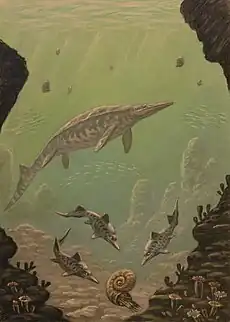
Thalattoarchon is known from the Favret Formation, which, along with the Prida Formation, constitutes one of two recognized geological formations of the Star Peak Group, located in Nevada. These two formations are linked by a single member, known as the Fossil Hill Member. In the Prida Formation, this member outcrops west of the Humboldt Range, and extends to the Favret Formation, outcropping the Augusta Mountains,[13] where it reaches up to more than 300 m wide.[14][5] Although they are neighbors, the two formations do not share precisely the same age, the Prida one dating from the Middle Anisian, while Favret dates from the Late Anisian,[14] between approximately 244 and 242 million years ago.[5] The Anisian is the first of two stratigraphic stages of the Middle Triassic, spanning 247.2 to 242 million years ago.[15]
The significant presence of marine reptiles, ammonites and other invertebrates in the Fossil Hill Member indicates that the surface waters were well aerated,[13] but there is however little animal presence in the benthic zones, with the notable exception of bivalves of the Halobiidae family. The fossils found show that the rock unit was once a pelagic ecosystem with a stable food web. Bony fish are little known and have currently only been discovered in the Favret Formation. Among the fish discovered, we find the actinopterygians Saurichthys and an undetermined representative,[16] while among the sarcopterygians, numerous specimens of indeterminate coelacanthids are known.[5] The most abundant marine reptiles of the Fossil Hill Member are the ichthyosaurs, including Thalattoarchon itself, Phalarodon, Omphalosaurus and the large Cymbospondylus. Few other marine reptiles are known from the Fossil Hill Member, the only clearly identified being the sauropterygian Augustasaurus.[1][4][12][5]
See also
Notes
References
- 1 2 3 4 5 6 7 8 9 10 11 12 13 Nadia B. Fröbisch; Jörg Fröbisch; P. Martin Sander; Lars Schmitz; Olivier Rieppel (2013). "Macropredatory ichthyosaur from the Middle Triassic and the origin of modern trophic networks". Proceedings of the National Academy of Sciences of the United States of America. 110 (4): 1393–1397. Bibcode:2013PNAS..110.1393F. doi:10.1073/pnas.1216750110. PMC 3557033. PMID 23297200.
- 1 2 3 Riley Black (January 7, 2013). "Sharp-Toothed Thalattoarchon Was the First Ruler of the Triassic Seas". National Geographic. Archived from the original on May 7, 2021.
- 1 2 3 4 5 Field Museum (January 7, 2013). "Giant fossil predator provides insights into the rise of modern marine ecosystem structures". ScienceDaily.
- 1 2 3 4 5 6 7 8 9 10 11 Nadia B. Fröbisch; Jörg Fröbisch; P. Martin Sander; Lars Schmitz; Olivier Rieppel (2013). "Supporting Information" (PDF). Proceedings of the National Academy of Sciences of the United States of America. doi:10.1073/pnas.1216750110.
- 1 2 3 4 5 6 7 P. Martin Sander; Eva Maria Griebeler; Lars Schmitz (2021). "Supplementary Materials for Early giant reveals faster evolution of large body size in ichthyosaurs than in cetaceans" (PDF). Science. doi:10.1126/science.abf5787.
- 1 2 Ryan Marek (2015). "Fossil Focus: Ichthyosaurs". Palaeontology Online. 5: 8. Archived from the original on 18 January 2021. Retrieved 13 June 2020.
- ↑ Cheng Ji; Da-Yong Jiang; Ryosuke Motani; Olivier Rieppel; Wei-Cheng Hao; Zuo-Yu Sun (2017). "Phylogeny of the Ichthyopterygia incorporating recent discoveries from South China". Journal of Vertebrate Paleontology. 36 (1): e1025956. doi:10.1080/02724634.2015.1025956. S2CID 85621052.
- ↑ Da-Yong Jiang; Ryosuke Motani; Jian-Dong Huang; Andrea Tintori; Yuan-Chao Hu; Olivier Rieppel; Nicholas C. Fraser; Cheng Ji; Neil P. Kelley; Wan-Lu Fu; Rong Zhang (2016). "A large aberrant stem ichthyosauriform indicating early rise and demise of ichthyosauromorphs in the wake of the end-Permian extinction". Scientific Reports. 6: 26232. Bibcode:2016NatSR...626232J. doi:10.1038/srep26232. PMC 4876504. PMID 27211319.
- 1 2 Benjamin C. Moon (2017). "A new phylogeny of ichthyosaurs (Reptilia: Diapsida)" (PDF). Journal of Systematic Palaeontology. 17 (2): 129–155. doi:10.1080/14772019.2017.1394922. S2CID 90912678.
- ↑ Jian-dong Huang; Ryosuke Motani; Da-yong Jiang; Xin-xin Ren; Andrea Tintori; Olivier Rieppel; Min Zhou; Yuan-chao Hu; Rong Zhang (2020). "Repeated evolution of durophagy during ichthyosaur radiation after mass extinction indicated by hidden dentition". Scientific Reports. 10 (1): 7798. Bibcode:2020NatSR..10.7798H. doi:10.1038/s41598-020-64854-z. PMC 7210957. PMID 32385319.
- ↑ Gabriele Bindellini; Andrzej S. Wolniewicz; Feiko Miedema; Torsten M. Scheyer; Cristiano Dal Sasso (2021). "Cranial anatomy of Besanosaurus leptorhynchus Dal Sasso & Pinna, 1996 (Reptilia: Ichthyosauria) from the Middle Triassic Besano Formation of Monte San Giorgio, Italy/Switzerland: taxonomic and palaeobiological implications". PeerJ. 9: e11179. doi:10.7717/peerj.11179. PMC 8106916. PMID 33996277.
- 1 2 3 P. Martin Sander; Eva Maria Griebeler; Nicole Klein; Jorge Velez Juarbe; Tanja Wintrich; Liam J. Revell; Lars Schmitz (2021). "Early giant reveals faster evolution of large body size in ichthyosaurs than in cetaceans". Science. 374 (6575): eabf5787. doi:10.1126/science.abf5787. PMID 34941418. S2CID 245444783.
- 1 2 Kathryn M. Nichols; Norman J. Silberling (1977). Stratigraphy and depositional history of the Star Peak Group (Triassic), northwestern Nevada. Vol. 175–178. Boulder: Geological Society of America, Special Papers. p. 73. doi:10.1130/SPE178-p1. ISBN 978-0-813-72178-1. S2CID 129115608.
- 1 2 Nicole Klein; Lars Schmitz; Tanja Wintrich; P. Martin Sander (2020). "A new cymbospondylid ichthyosaur (Ichthyosauria) from the Middle Triassic (Anisian) of the Augusta Mountains, Nevada, USA". Journal of Systematic Palaeontology. 18 (14): 1167–1191. doi:10.1080/14772019.2020.1748132. S2CID 219078178.
- ↑ "International Chronostratigraphic Chart" (PDF). International Commission on Stratigraphy. 2015.
- ↑ P. Martin Sander; Olivier C. Rieppel; H. Bucher (1994). "New Marine Vertebrate Fauna from the Middle Triassic of Nevada". Journal of Paleontology. 68 (3): 676–680. doi:10.1017/S0022336000026020. JSTOR 1306213. S2CID 133180790.
